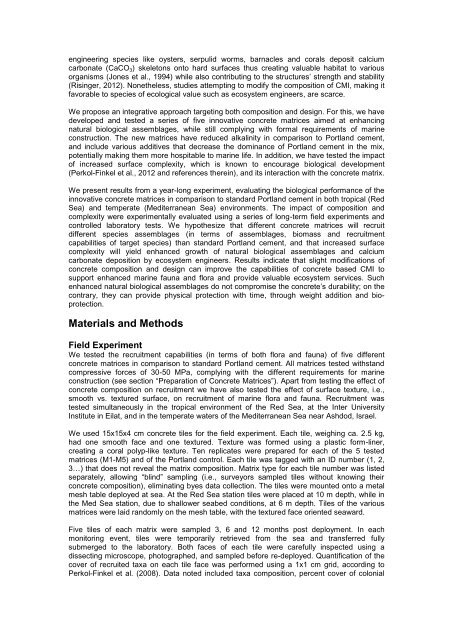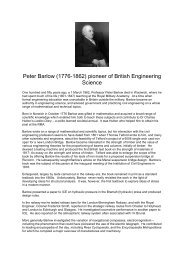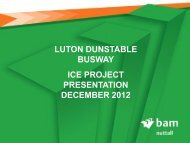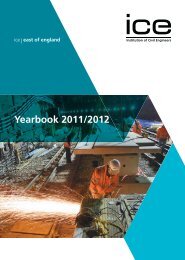Ecologically Active - Institution of Civil Engineers
Ecologically Active - Institution of Civil Engineers
Ecologically Active - Institution of Civil Engineers
You also want an ePaper? Increase the reach of your titles
YUMPU automatically turns print PDFs into web optimized ePapers that Google loves.
engineering species like oysters, serpulid worms, barnacles and corals deposit calcium<br />
carbonate (CaCO 3 ) skeletons onto hard surfaces thus creating valuable habitat to various<br />
organisms (Jones et al., 1994) while also contributing to the structures’ strength and stability<br />
(Risinger, 2012). Nonetheless, studies attempting to modify the composition <strong>of</strong> CMI, making it<br />
favorable to species <strong>of</strong> ecological value such as ecosystem engineers, are scarce.<br />
We propose an integrative approach targeting both composition and design. For this, we have<br />
developed and tested a series <strong>of</strong> five innovative concrete matrices aimed at enhancing<br />
natural biological assemblages, while still complying with formal requirements <strong>of</strong> marine<br />
construction. The new matrices have reduced alkalinity in comparison to Portland cement,<br />
and include various additives that decrease the dominance <strong>of</strong> Portland cement in the mix,<br />
potentially making them more hospitable to marine life. In addition, we have tested the impact<br />
<strong>of</strong> increased surface complexity, which is known to encourage biological development<br />
(Perkol-Finkel et al., 2012 and references therein), and its interaction with the concrete matrix.<br />
We present results from a year-long experiment, evaluating the biological performance <strong>of</strong> the<br />
innovative concrete matrices in comparison to standard Portland cement in both tropical (Red<br />
Sea) and temperate (Mediterranean Sea) environments. The impact <strong>of</strong> composition and<br />
complexity were experimentally evaluated using a series <strong>of</strong> long-term field experiments and<br />
controlled laboratory tests. We hypothesize that different concrete matrices will recruit<br />
different species assemblages (in terms <strong>of</strong> assemblages, biomass and recruitment<br />
capabilities <strong>of</strong> target species) than standard Portland cement, and that increased surface<br />
complexity will yield enhanced growth <strong>of</strong> natural biological assemblages and calcium<br />
carbonate deposition by ecosystem engineers. Results indicate that slight modifications <strong>of</strong><br />
concrete composition and design can improve the capabilities <strong>of</strong> concrete based CMI to<br />
support enhanced marine fauna and flora and provide valuable ecosystem services. Such<br />
enhanced natural biological assemblages do not compromise the concrete’s durability; on the<br />
contrary, they can provide physical protection with time, through weight addition and bioprotection.<br />
Materials and Methods<br />
Field Experiment<br />
We tested the recruitment capabilities (in terms <strong>of</strong> both flora and fauna) <strong>of</strong> five different<br />
concrete matrices in comparison to standard Portland cement. All matrices tested withstand<br />
compressive forces <strong>of</strong> 30-50 MPa, complying with the different requirements for marine<br />
construction (see section “Preparation <strong>of</strong> Concrete Matrices”). Apart from testing the effect <strong>of</strong><br />
concrete composition on recruitment we have also tested the effect <strong>of</strong> surface texture, i.e.,<br />
smooth vs. textured surface, on recruitment <strong>of</strong> marine flora and fauna. Recruitment was<br />
tested simultaneously in the tropical environment <strong>of</strong> the Red Sea, at the Inter University<br />
Institute in Eilat, and in the temperate waters <strong>of</strong> the Mediterranean Sea near Ashdod, Israel.<br />
We used 15x15x4 cm concrete tiles for the field experiment. Each tile, weighing ca. 2.5 kg,<br />
had one smooth face and one textured. Texture was formed using a plastic form-liner,<br />
creating a coral polyp-like texture. Ten replicates were prepared for each <strong>of</strong> the 5 tested<br />
matrices (M1-M5) and <strong>of</strong> the Portland control. Each tile was tagged with an ID number (1, 2,<br />
3…) that does not reveal the matrix composition. Matrix type for each tile number was listed<br />
separately, allowing “blind” sampling (i.e., surveyors sampled tiles without knowing their<br />
concrete composition), eliminating byes data collection. The tiles were mounted onto a metal<br />
mesh table deployed at sea. At the Red Sea station tiles were placed at 10 m depth, while in<br />
the Med Sea station, due to shallower seabed conditions, at 6 m depth. Tiles <strong>of</strong> the various<br />
matrices were laid randomly on the mesh table, with the textured face oriented seaward.<br />
Five tiles <strong>of</strong> each matrix were sampled 3, 6 and 12 months post deployment. In each<br />
monitoring event, tiles were temporarily retrieved from the sea and transferred fully<br />
submerged to the laboratory. Both faces <strong>of</strong> each tile were carefully inspected using a<br />
dissecting microscope, photographed, and sampled before re-deployed. Quantification <strong>of</strong> the<br />
cover <strong>of</strong> recruited taxa on each tile face was performed using a 1x1 cm grid, according to<br />
Perkol-Finkel et al. (2008). Data noted included taxa composition, percent cover <strong>of</strong> colonial







